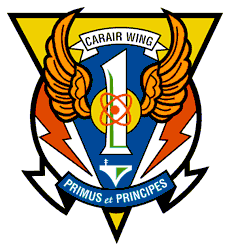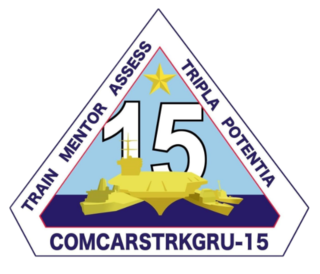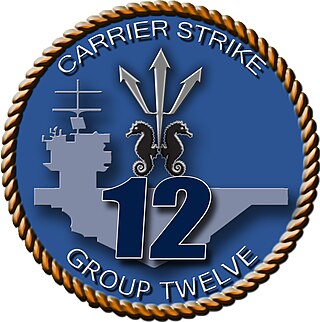
USS Abraham Lincoln (CVN-72) is the fifth Nimitz-class aircraft carrier in the United States Navy. She is the second Navy ship to have been named after the former President Abraham Lincoln. Her home port is NAS North Island, San Diego, California; she is a member of the United States Pacific Fleet. She is administratively responsible to Commander, Naval Air Forces Pacific, and operationally serves as the flagship of Carrier Strike Group 3 and host to Carrier Air Wing Nine. She was returned to the fleet on 12 May 2017, marking the successful completion of her Refueling and complex overhaul (RCOH) carried out at Newport News Shipyard. On 1 April 2019, USS Abraham Lincoln was deployed to the Middle East as the flagship for Carrier Strike Group 12 and Carrier Air Wing Seven assigned to her.

Carrier Strike Group 9 is a U.S. Navy carrier strike group. Carrier strike groups gain and maintain sea control as well as project naval airpower ashore. Commander Carrier Strike Group 9 is responsible for unit-level training, integrated training, and material readiness for the ships and aviation squadrons assigned to the group. The group reports to Commander, U.S. Third Fleet, which also supervises its pre-deployment training and certification that includes Composite Unit Training Exercises.

USS Harry S. Truman (CVN-75) is the eighth Nimitz-class aircraft carrier of the United States Navy, named after the 33rd President of the United States, Harry S. Truman. She is currently homeported at Naval Station Norfolk, Virginia.

Carrier Air Wing One (CVW-1) is a United States Navy aircraft carrier air wing based at Naval Air Station Oceana, Virginia, with most of its various squadrons also home based at NAS Oceana. Additional squadrons are based at Naval Station Norfolk/Chambers Field, Virginia; Marine Corps Air Station Beaufort, South Carolina; Naval Air Station Whidbey Island, Washington; and Naval Air Station Jacksonville, Florida.

Carrier Air Wing Seven (CVW-7) is a United States Navy aircraft carrier air wing based at Naval Air Station Oceana, Virginia. At the moment, CVW-7 is assigned to the USS George H. W. Bush. The tail code of aircraft assigned to CVW-7 is AG.

Commander, Naval Air Force Atlantic is the aviation Type Commander (TYCOM) for the United States Naval aviation units operating primarily in the Atlantic under United States Fleet Forces Command. Type Commanders are in administrative control (ADCON), and in some cases operational control (OPCON) of certain types of assets assigned to the Pacific and Atlantic Fleets. AIRLANT is responsible for the material readiness, administration, training, and inspection of units/squadrons under their command, and for providing operationally ready air squadrons and aircraft carriers to the fleet.

Carrier Strike Group 10, abbreviated as CSG-10 or CARSTRKGRU 10, is a U.S. Navy carrier strike group. Carrier strike groups gain and maintain sea control as well as project naval airpower ashore.

Carrier Strike Group 11 is a U.S. Navy carrier strike group. Carrier strike groups gain and maintain sea control as well as project naval airpower ashore.

Carrier Strike Group One is a U.S. Navy carrier strike group. USS Carl Vinson (CVN-70) is the strike group's current flagship, and other units currently assigned are the ship's Carrier Air Wing 2 and embarked Destroyer Squadron 1, deployed with Ticonderoga-class guided-missile cruiser USS Lake Champlain, as well as Arleigh Burke-class guided-missile destroyers USS Michael Murphy and USS Wayne E. Meyer.

Carrier Strike Group 2 is a U.S. Navy carrier strike group, tracing its history originally to 1931. The aircraft carrier USS Dwight D. Eisenhower is the strike group's current flagship. As of Aug 2020, other units assigned to Carrier Strike Group 2 included the nine squadrons of Carrier Air Wing Three; the Ticonderoga-class cruiserUSS Philippine Sea (CG-58); USS Monterey (CG-61), USS Vella Gulf (CG-72) and the Arleigh Burke-class destroyersUSS Mitscher (DDG-57), USS Laboon, USS Mahan (DDG-72), and USS Thomas Hudner (DDG-116) from Destroyer Squadron 22.

Carrier Strike Group 3 is a U.S. Navy carrier strike group. Carrier strike groups gain and maintain sea control as well as project naval airpower ashore. The aircraft carrier USS Abraham Lincoln (CVN-72) is the group's current flagship. Other units assigned include Carrier Air Wing Nine; the Ticonderoga-class cruiserUSS Mobile Bay (CG-53); and the ships of Destroyer Squadron 21.

Commander, Carrier Strike Group FOUR is the U.S. Fleet Forces Command formation charged with training and certifying Atlantic Fleet Carrier Strike Groups, Amphibious Ready Groups, and independently deploying surface ships. Its mission is to "Conduct safe and effective Strike Force Training of the Atlantic Fleet."

Carrier Strike Group 15, is a training formation of the United States Navy. It trains and certifies Pacific Fleet Carrier Strike Groups, Amphibious Ready Groups, and independently deploying surface ships. It replaced Commander, Strike Force Training Pacific in a title change. Carrier Strike Group Four is the equivalent command for US Fleet Forces ships.

Carrier Strike Group Seven was a U.S. Navy carrier strike group active from October 2004 until 30 December 2011. The strike group's antecendants included two previous aircraft carrier formations, Carrier Division Seven and Carrier Group Seven. Its heritage thus includes the Second World War, the Vietnam War, and the Cold War, as well as the first and the second Persian Gulf wars, encompassing a total of 34 deployments to the Western Pacific Ocean and Persian Gulf.

Carrier Strike Group Ten was involved in a number of operations between 2004–2009. Carrier Strike Group Ten was a U.S. Navy carrier strike group. In 2004–09 it was based at Naval Station Norfolk. In those five years it made two Middle East providing air and naval support for the War in Iraq and the War in Afghanistan, as well as Operation Vigilant Resolve, and Joint Task Force Exercise 05-2 . In 2004–09 the group's flagship was the Nimitz-class nuclear-powered aircraft carrierUSS Harry S. Truman (CVN-75).

Carrier Strike Group Three 2004–2009 operations included a world cruise, three western Pacific (WESTPAC) deployments and a change-over of its flagship. During this period, CARSTRGRU-3 provided combat operational support for Operation Iraqi Freedom and Operation Enduring Freedom – Afghanistan (OEF-A) as well as participated such major exercises as Valiant Shield 2007, Key Resolve/Foal Eagle 2009, and Northern Edge 2009. The strike group's 2005 WESTPAC deployment marked the final overseas mission for Sea Control Squadron 33 (VS-33), the Screwbirds. Helicopter Maritime Strike Squadron 71 (HSM-71), a new component to Carrier Air Wing Nine (CVW-9), became the first squadron of its kind to embark on board a carrier as part of a carrier air wing when it operated with Carrier Strike Group Three during its 2009 WESTPAC deployment

Rear Admiral Jesse Alphonzo Wilson Jr. is a retired United States Navy officer. His last active duty assignment was as commander of Naval Surface Force Atlantic.

Summer Pulse 2004 (SP04) was the codename for a worldwide surge deployment that served as the first full-scale test of the United States Navy's then-new Fleet Response Plan (FRP). During Summer Pulse 2004, a total of seven carrier strike groups were underway at the same time in five different theaters of operations. This number of underway carrier strike groups had not been matched since the six carrier battle groups deployed during Operation Desert Storm. In addition to the carriers, the Navy also deployed 17 submarines and one submarine tender.

Carrier Strike Group Twelve is one of four U.S. Navy carrier strike groups currently assigned to the United States Fleet Forces Command. Carrier strike groups gain and maintain sea control as well as project naval airpower ashore.



















